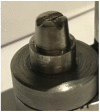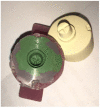Effect of Different Wax Pattern Manufacturing Techniques on the Marginal Fit of Lithium Disilicate Crowns
- PMID: 35888241
- PMCID: PMC9319464
- DOI: 10.3390/ma15144774
Effect of Different Wax Pattern Manufacturing Techniques on the Marginal Fit of Lithium Disilicate Crowns
Abstract
Purpose: The present study evaluated the marginal gap of lithium disilicate crowns fabricated through three different wax pattern techniques; Conventional, Milling and 3D-printing. Materials and Methods: Thirty stone models were replicated from a stainless-steel model representing a prepared tooth; ten were sent to make conventional wax patterns while the remaining were sent to a digital dental scanner. The computer aided design was completed and STL (Standard Tessellation Language) files were sent to either milling or 3D-printing machines. All wax patterns (n = 30) were pressed, and a stabilizing instrument was used to secure the crowns on the master model. The marginal gap was measured at 18 points for each crown using a digital microscope (µm) (n = 540) and compared using One-way ANOVA (p ≤ 0.05). Results: There was a significant difference in the marginal gap value between all three groups (p < 0.01) where the milled group showed the least mean gap (28.87 ± 30.18 µm), followed by 3D printed (47.85 ± 27.44 µm), while the highest mean marginal gap was found in the conventional group (63.49 ± 28.05 µm). Conclusion: Milled and 3D-printed wax patterns produced better fitting crowns compared to conventional techniques.
Keywords: 3D-printing; Cad/CAM; ceramic crown; lithium disilicate; marginal fit; wax pattern.
Conflict of interest statement
The authors declare no conflict of interest.
Figures
References
-
- Coli P., Karlsson S. Fit of a new pressure-sintered zirconium dioxide coping. Int. J. Prosthodont. 2004;17:59–64. - PubMed
-
- Keshvad A., Hooshmand T., Asefzadeh F., Khalilinejad F., Alihemmati M., van Noort R. Marginal Gap, Internal Fit, and Fracture Load of Leucite-Reinforced Ceramic Inlays Fabricated by CEREC inLab and Hot-Pressed Techniques. J. Prosthodont. 2011;20:535–540. doi: 10.1111/j.1532-849X.2011.00745.x. - DOI - PubMed
LinkOut - more resources
Full Text Sources
Miscellaneous






